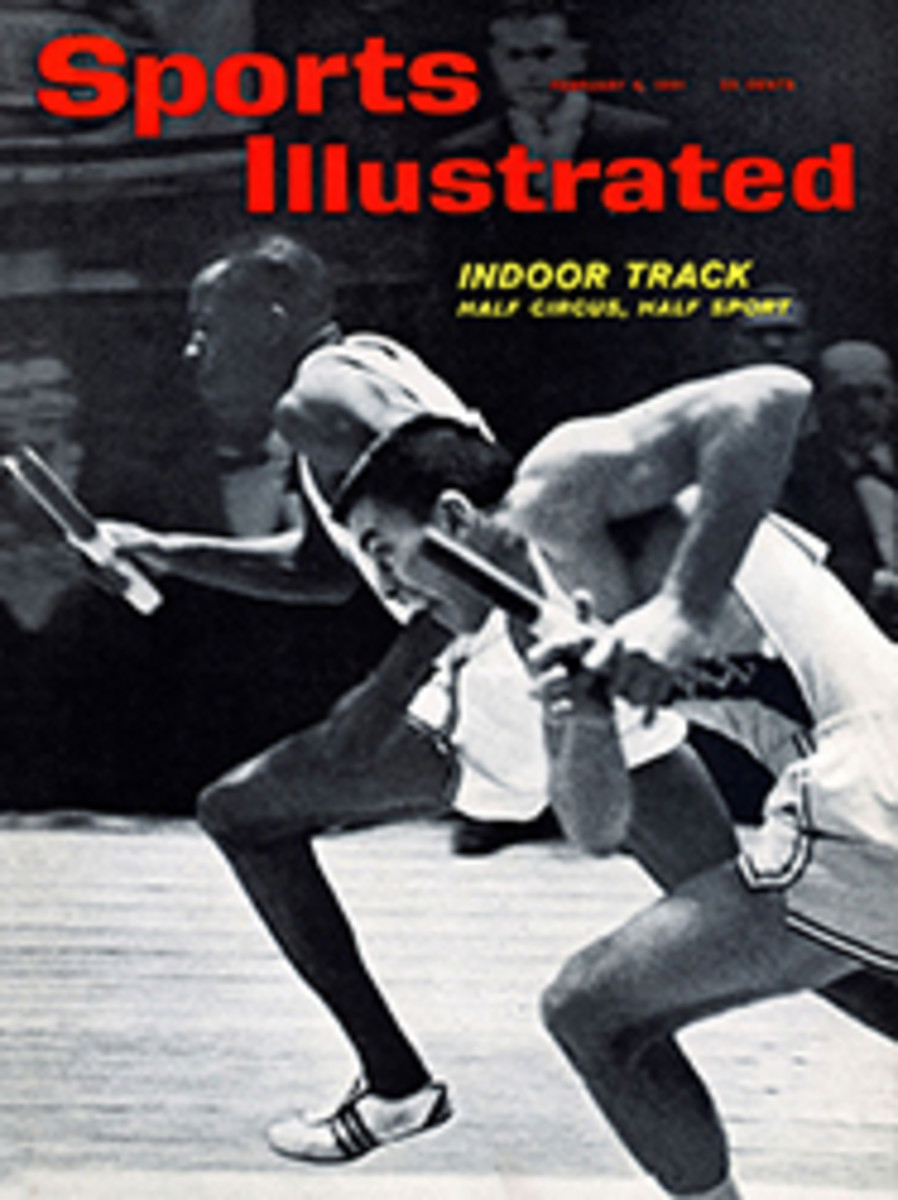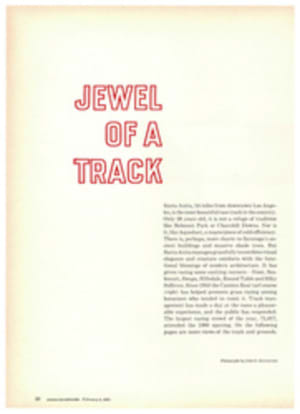
A long-neglected art is now flourishing again
There is more pleasure in attacking than defending," Montaigne wrote 400 years ago, and nowhere could the French essayist have found a more devoted group of disciples than among the coaches of modern basketball. While scores have risen into the 70s, 80s and finally the 100s in recent years, teams have stampeded up and down the floor displaying no more interest in defense than Ted Williams did in bunting.
The excuse coaches offer for this neglect of defensive basketball is that neither fans nor players like it. This is half-truth at best. It leaves unmentioned the real reason: the teaching of defensive basketball requires a great deal of effort, and many coaches have simply been too lazy to bother. Others wouldn't know how to teach defensive tactics if they were inclined to do so. And because the players have been shooting baskets since grammar school days, refining their offensive style until it is as natural as a politician's hand wave, but have ignored defense because it is unnatural and bothersome, they must be taught fundamentals at the college level.
Thus it is intriguing to observe this season a subtle yet significant increase in the coaching of better basketball; i.e., the training of tough and meticulously drilled defenses combined with disciplined offenses. This freshening interest in defense is showing itself across the country, from the Southwest, where Coach Abe Lemons of Oklahoma City finds "a slowdown trend in the game and defenses that are a lot rougher," through the Midwest, where Michigan State's Forddy Anderson says, "Coaches in general are paying more attention to defense, instead of only shoot and run," to the East, where Frank McGuire of North Carolina says, "This conference [the ACC] was weak defensively, but of late we have taken up strong man-for-man defenses."
The change in the game is no mere shift in style, as if basketball's hemlines had gone up three inches, only to be coming down again soon. Basketball has had several such style shifts, perhaps the most dramatic being the one which occurred about 20 years ago when the East was still playing its delicate pass, pass, pass brand of offense that would finally shake a man clear for a pretty, two-handed set shot. Along came West and Midwest teams with one-hand jump shots and fast attacks that riddled the East. The East responded, changing to the fast-break brand of basketball many teams still play today. That was a change of style. The present growing emphasis on defense is less dramatic and obvious than that, but should, in the end, be even more significant.
All along, of course, there have been coaches who worked hard on defense—Dudey Moore of LaSalle, Harry Litwack of Temple, Ray Meyer of DePaul, Adolph Rupp of Kentucky, Hank Iba of Oklahoma State, among them—but they have been so few that the present trend was slow in coming. It actually began when two West Coast teams, the University of San Francisco and the University of California, coached by two close friends, Phil Woolpert and Pete Newell, used varied, aggressive man-to-man defenses and extremely deliberate offenses to win three national championships in five years.
The significance of Woolpert's success was somewhat ambiguous, because USF had a genuine superstar in Bill Russell. Many coaches felt, and reasonably so, that it was Russell, not Woolpert's defense, that made the team a winner. But when Newell took a California team of relative unknowns to the NCAA finals in 1959, and there used a tight defense to defeat high-scoring West Virginia for the championship, there was no escaping the fact that defensive basketball was also winning basketball.
Since then, Newell, now the athletic director at California, has become the recognized spokesman for the defense. "He has conducted so many clinics east of the Mississippi River that he has made a national thing out of this," says Frank McGuire.
"In one of my recent clinics," Newell recalled last week, "there were three Big Ten coaches. They showed a definite interest. I think this interest is being reflected in Big Ten play already." (Purdue upset offense-minded Iowa, which had averaged 78 points a game, by the remarkably low score of 47-41 two weeks ago, thanks largely to an ubiquitous Purdue defense that allowed Iowa only three baskets in the first half.) Newell cited three top teams, Ohio State, Auburn and Mississippi State, as squads that were "gaining the rewards of an active defense this year."
Another is St. Louis University, which last week upset highly ranked St. John's University 60-57 in a test of conflicting styles. St. John's, a quick-shooting team with a pell-mell approach, not only found itself slowed down by the pressing defense of St. Louis, but ended up getting 16 less shots than the winners because it was harassed into making repeated errors. St. Louis, coached by John Benington, who once played and coached under Pete Newell, often gets more shots than an opponent in spite of its deliberate offense. St. Louis' edge in the number of shots has been remarkably high this season against teams that like to shoot; i.e., 30 more than Drake, 21 more than Wichita and 36 more than Louisville.
Because offense and defense are so closely linked on a basketball court—there is no sharp break between the two as there is after baseball's three outs or football's four downs—it is debatable whether a team can successfully adopt Newell's defensive techniques without accepting his deliberate offense, too. Some coaches decry this offense as the ruination of college basketball from the paying spectator's point of view. But the evidence thus far is that deliberate offenses have not accompanied the trend to tougher defenses.
Long-ignored maxims
In teaching and preaching the virtues of defense, Newell stresses what amounts to maxims for containing an opposing team, maxims that apparently apply regardless of a team's own offensive style. If none are really new, all have been long ignored. Among them:
"Always keep pressure on the ball. This increases an opponent's mistakes. A mistake is worth 1.5 points to you.
"A player is without the ball 36 to 40 minutes of the game. The first step is to increase his efficiency for those 36 minutes.
"Your offensive efficiency varies from game to game. On those nights when your offense is off, a solid defense will enable you to win.
"Man-to-man defense in college must be taught from scratch. Thus a coach can bring out skills in a player that otherwise might never have been discovered.
"Defense appeals to the intelligent player.
"Don't worry about audience reaction if you concentrate on defense. Winning is the best excuse. The fans don't complain when the score is right."
Three thousand miles east of Pete Newell one afternoon last week a young advocate of thorough, precise defensive basketball was sitting in the quiet emptiness of Madison Square Garden. While his New York University team was warming up for a practice session, Lou Rossini analyzed the new interest in defense.
"Like the Russians"
"A neglected art for so many years," he said sadly. "You'd go into a dressing room at half time and all you'd hear the coach talking about was offensive strategy—break fast, when this guy shoots, try for a one-on-one with that guy. This is changing now. Basketball has become a science. Coaches are finding they can't get along without a detailed knowledge of every aspect of the game. Their teams have to play both offense and defense 100% or they can't win the big ones any more. So you go into a dressing room at half time this season and chances are you'll hear defensive talk—stop this pick, make that switch."
Rossini jabbed the air with his cigar to emphasize the point. "It's like the Russians and the sputniks. You go along, go along, go along and everybody is doing O.K. and being a good guy. Then along comes a fellow who isn't content to be a good guy. Bang! Bang! Bang! He's got sputniks going around the world. So you get scared. Your pride is hurt. You do more work in one year than you did in the last 15.
"Same way in basketball. Fear and pride have made coaches finally go to work on defensive basketball. Mostly fear. I'd have to say mostly fear. And it's paying off in a better game."
Then Lou Rossini walked to the court to start the NYU practice. The emphasis, of course, was on defense, just as it is at a growing number of practice sessions throughout the country this season, Montaigne's philosophy notwithstanding.
PHOTO
DEFENSE ADVOCATE Lou Rossini of NYU sees new trend toward more disciplined game.

